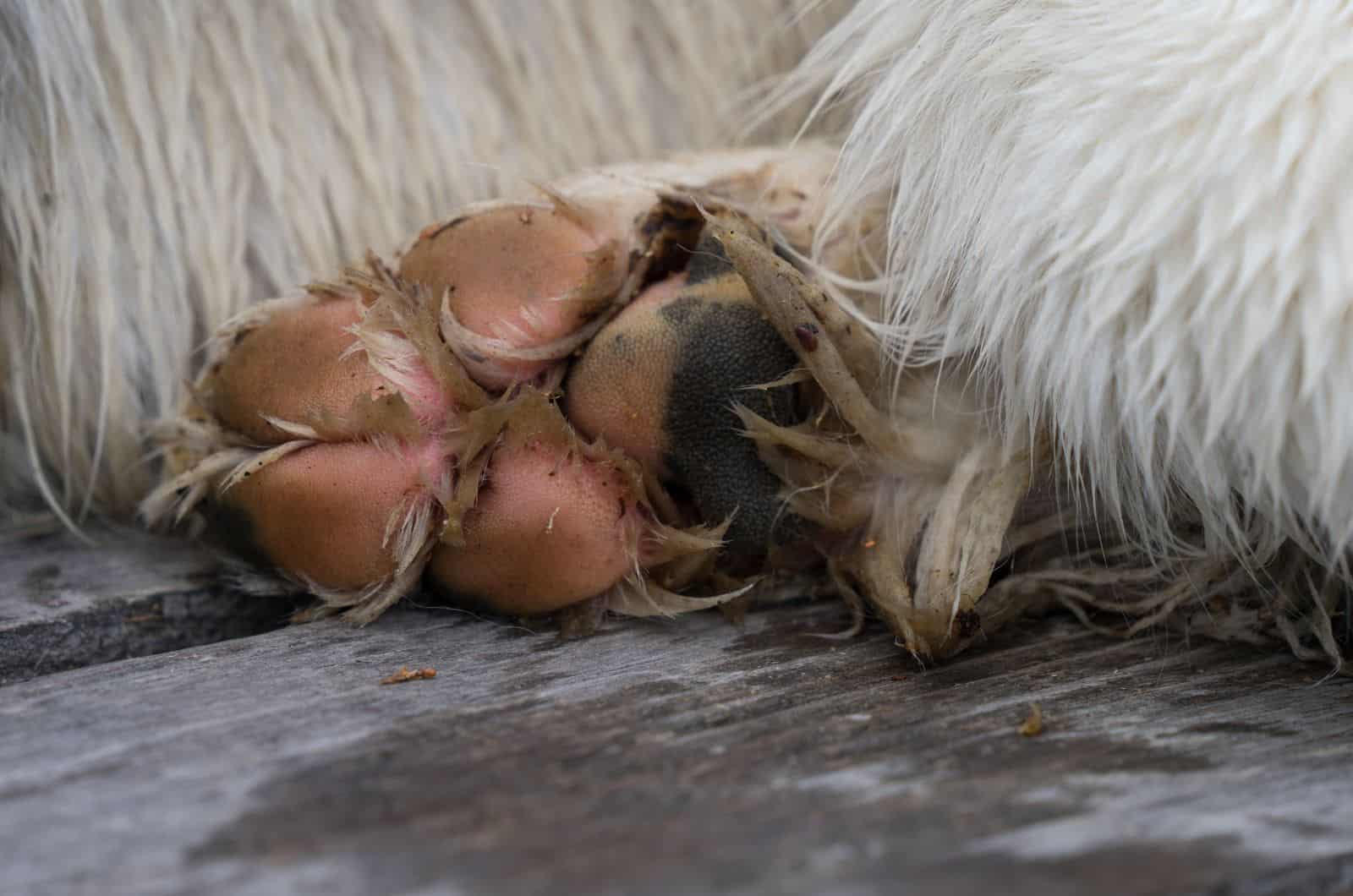You may have wondered at some point why your dog’s paws are pink despite everything else about him being a completely different color, and that’s what we’re here to answer today.
It should come as no surprise that a dog’s paws are pink as that’s the case with most young pups. There’s at least some pink on every dog’s paw and yours is no different as those are paw pads which are made of fatty tissue, hence the coloration.
Some have a dark layer over it, but it should still have a little bit of pink peeking out in spots.
The pink areas are usually the softest and most sensitive parts of the paw and are mostly present in pups, and will get the black layer through gradual use.
However, the pink paw pads are usually only a puppy trait and said black protective layer should be present in most dog breeds.
If it isn’t, it may look concerning, but it really isn’t that drastic of a deal.
However, it’s still worth noting what causes it and how best to treat it as it can cause some level of irritation for your canine companion that you’ll want to resolve as soon as you can to remove said source of irritation.
The sources of pink paw pads in adult dogs can vary from allergy to a self-induced problem, and I’m here to teach you all about it.
So, read on to find out the many causes of pink paw pads or the lack of the black protective layer on them in adult dogs as well as the corresponding treatment methods.
The Dogs Paws Are Pink. Is That Normal?

It is, in most dogs, the younger ones at least. Adult dogs often have the black crust-like protective layer that covers them to protect them.
The pink areas are often sensitive and can cause your dog some mild discomfort when walking on them, but the pups get used to it over time as said protective layers build up.
The pink color comes from their skin color that’s mixed in with some elastic fatty tissue on that specific area, giving it the appearance of a soft pillow.
The protective layer can get removed through various methods, most of them unintentional, some a bit less so, but seeing the pink every now and then is nothing unusual and the reason is often temporary if treated properly.
The paw’s pigmentation may even stay pink throughout a dog’s life, though that’s only for a small number of dog breeds.
Others may even see a partial dark pigmentation with a few pink spots still lingering.
What Purpose Do The Pink Paw Pads Serve?
Well, they serve a number of functions. The main one is to act as a bit of traction for the surface the doggo is walking on.
The softness of the pads also plays a great role in increasing overall balance and stability.
They also help relieve some of the stress from walking on particularly hard ground as the elastic fatty tissues that the pads are built from provide a level of shock absorption.
This way, the dog jumping around doesn’t impact his body as severely as it would without them.
What Causes The Appearance Of Pink Paws In Adult Dogs?
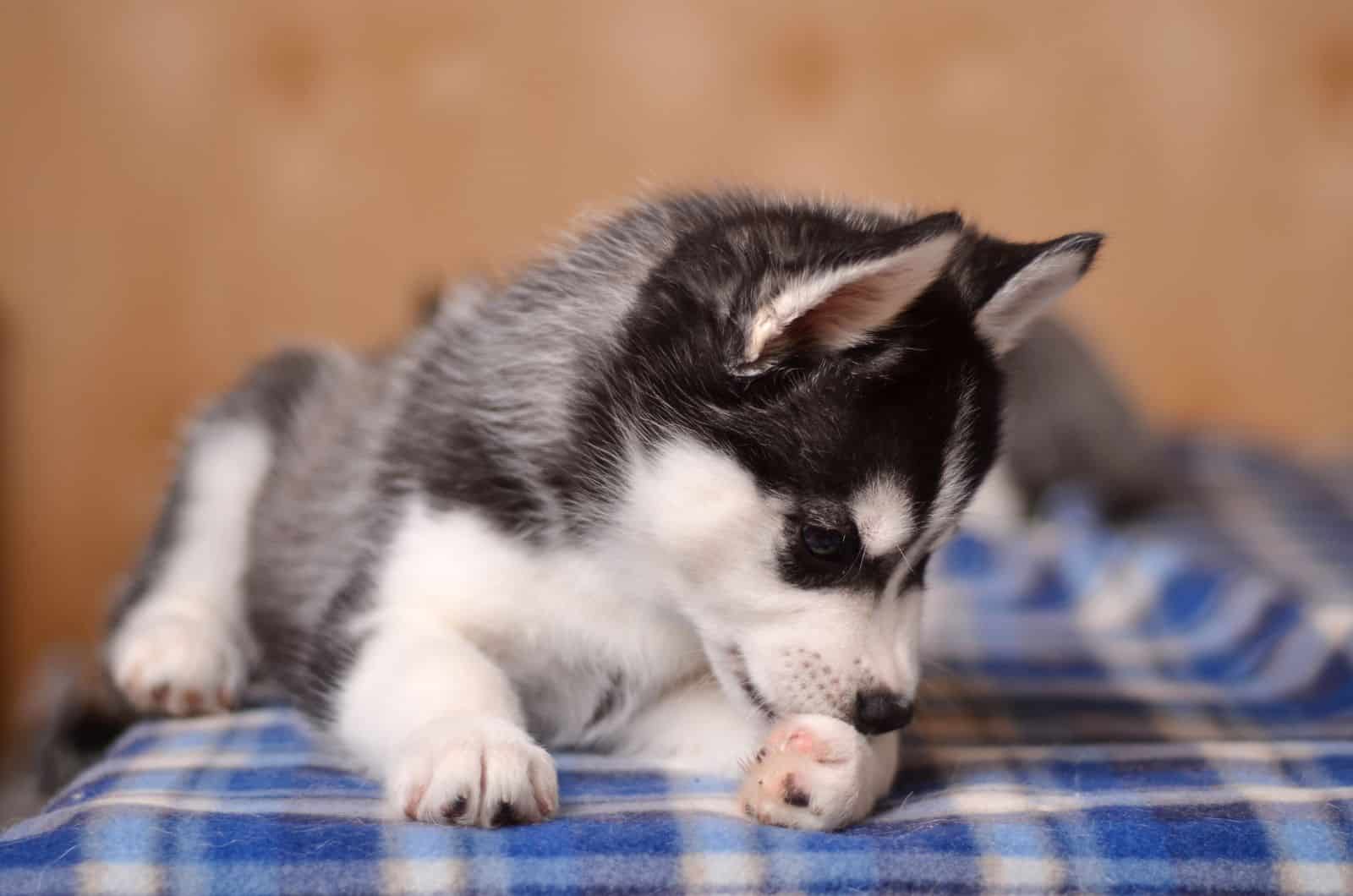
Though an adult dog is meant to have the black protective layer showing, sometimes it can crack, peel away, or simply not be present due to an unforeseen accident.
Plenty of things can be the cause.
Here are some of the more common ones:
1. An Allergic Reaction
One of the main reasons as to why a dog may be getting the pink showing back up again on his paws is due to an allergic reaction irritating the area which then leads to him trying to soothe it down by licking away at the affected area.
The particular name of the issue is called atopy, when the allergen affects the paws themselves and causes an irritation.
Naturally, your doggo wants to get rid of the issue in question so he’s likely to scrape off some of that black protective layer from excessive licking if the irritation is strong enough.
On the topic of prevention, the best way to do so is find out what exactly the trigger is and avoid it as best you can.
If it’s something that happens from interacting with a specific surface, then you can always clean your dog’s paws after a walk. That should help deal with any itchy paws and will provide your pupper with almost instant relief.
If you can’t due to the allergen being something completely different or unavoidable, then various shampoos can help stave off the symptoms of said allergies, or at the very least lessen them so it doesn’t come to pink paw exposure.
Alternatively, there’s always allergy medication to consider if your dog doesn’t fight it too much, or an allergy shot which can help the body get used to the trigger.
However, identifying the root cause through allergy testing is key here as none of these steps would be possible otherwise, and early detection means earlier prevention.
Also, do keep in mind that some prevention methods may not work on their own depending on the severity of the symptoms themselves and you may have to employ several methods in order to hopefully eliminate them.
2. A Cyst
There’s nothing more obnoxious than an abnormal growth on a foot, be it for humans or pets.
A cyst is one such growth that forms from clogged hair follicles and blocked ducts.
They’re somewhat uncommon, but a few dog breeds like the English Bulldog or the Golden Retriever, are more prone to getting them throughout their lives.
While not painful, it can be extremely uncomfortable to put pressure on, making pets appear as if they were limping when their legs are perfectly fine otherwise.
If it pops up under the black protective layer, it can crack through and show some of the pink fatty tissue through it.
It’s best to get rid of the cyst as fast as possible, and for that you’ll need a vet’s help to drain it and properly treat it so get your dog to the nearest one when you can.
After the problem is solved, the area should heal relatively quickly and your doggo should be able to walk almost immediately after the procedure.
3. An Infection
Speaking of nasty and bothersome growths, infections rank among some of the worst ones as they can wind up becoming real dangerous if left untreated or noticed too late.
The most common type of infection that they’ll face around their feet are bacterial infections, though fungal infections are known to rear their ugly head out from time to time as well.
The former usually happens due to extremely poor hygiene or due to a nutrient deficiency which can lead to a bacterial imbalance around the area between the paw pad pillows which are notorious for getting caked up with all sorts of stuff.
It can also be a developing skin infection that causes some sort of growth that’d make it uncomfortable to walk on the paw pads themselves, or an ingrown hair which can cause similar issues.
The best way to avoid most of these is to keep your dog out of any suspicious areas like swamps or dirty places as those are obviously going to be the breeding grounds for all sorts of potentially hazardous bacteria.
Should your dog end up contracting a bacterial infection, the treatment options are often simple, be it washing the bacteria off with a medicated shampoo or giving the dog antibiotics until the problem passes.
In some more serious cases, your dog may need to undergo surgery, but don’t worry, it’s routine stuff and usually has an extremely high success rate.
As far as fungal infections are concerned, they only occur through environmental effects, similar to that of regular bacterial infections.
Usually, it starts to develop if your dog’s immune system is compromised, even if temporarily, and usually due to an allergic reaction or a cold of some kind.
Thankfully, it’s easy to notice, though it may depend on the thickness of your dog’s fur.
It usually has a very unpleasant brownish-red color to it and is certainly not appealing to look at.
Some fungal and yeast infections may even end up having discharge which makes the affected area look extra disgusting.
These infections can make the protective layer crack once again and have it show the pink tissue underneath.
Or, your dog may end up feeling too irritated that he does the same thing he does in case of atopy, licks on his paws a bit too much and scrapes the layer off himself.
Thankfully, treating fungal infections is relatively simple as it involves utilizing medicated shampoos or topical ointments, much like one would with a bacterial one.
4. He May Have Suffered A Burn
Another nasty growth that may end up cracking that protective layer and showing your dog’s paws as pink are various burns and blisters.
These are sustained from extremely hot surfaces, especially when you take your dog out for a walk on a hot Summer’s day or if you live in a particularly toasty part of the US.
While discomfort is one of the most common problems with blisters and burns, the actual issue is that they’re a prerequisite for all sorts of infections, so it’s best that they’re treated quickly.
Speaking of which, should your dog suffer from a burn or a blister, find them a place to rest so they don’t have to keep themselves up on the affected area to keep it clean and prevent it from breaking so it doesn’t develop into an infection and worsen.
Aside from that, you’ll still want to either visit a vet or call one up for advice.
Then your precious pooch will likely have his affected leg bandaged up and be prescribed some antibiotics to help handle the issue while he recovers.
As far as preventing the problem goes, you’ll want to keep the dog away from any particularly hot surfaces when the heat outside is unbearable, especially asphalt or any metal grates or surfaces as those get particularly hot.
5. He May Have Gotten Hurt On Some Debris
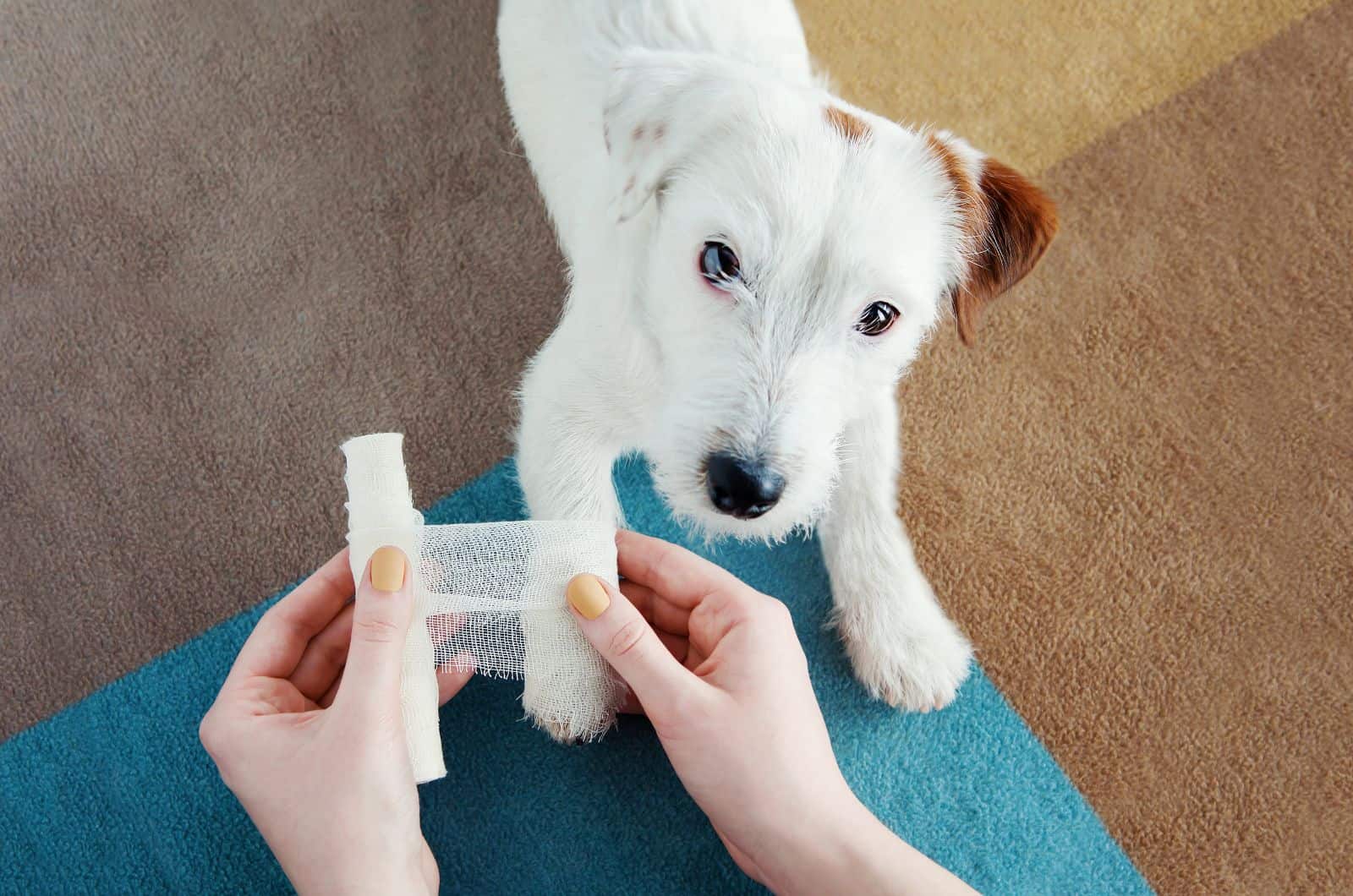
Another possible reason that can answer the question of “Why are my dog’s paws pink?” is that he may have walked or ran over an area that was full of sharp rocks or even glass or similarly problematic debris.
It could’ve cut up or gotten stuck in his pad and broken through the protective layer, exposing the fatty and elastic tissue underneath.
If the object has fully penetrated into it, you’ll need to extract it if it’s small enough for you to safely do so, otherwise you may need to call a vet for help so you can prevent a secondary infection from developing from said punctures.
Depending on the type of debris, your dog may be prescribed some antibiotics or topical ointment to help keep the impacted area safe from infection.
Read More: Red Bump On Dog Paw? What’s The Pawblem?
As for prevention methods, those mostly involve keeping a close eye on your dog and where he walks as well as keeping him away from dangerous materials in general.
6. His Nails May Have Caused The Issue
The issue isn’t caused by the nails themselves scraping the protective layer off, but rather due to the blood vessels found within the nail.
These can, if not trimmed properly, extend too long and act as an express highway for all sorts of bacteria to cause an infection on the paw pad.
Regular trimming is recommended, albeit it may require specialized help or knowledge as our dogs nails aren’t as easy to trim as ours may be.
7. He May Just Be Getting Old
While most dogs get black paws when they reach adulthood, the process can start reversing itself as he ages further, turning pink in certain places. It’s called marbling.
So, it’s pretty normal that the dog’s paws are pink at a more senior age for that very reason and it’s not really a cause for concern.
You’re likely to see this occur around other areas that are normally black that would lose a bit of pigmentation now like the dog’s lips or his nose for some dog breeds.
8. It’s Just Genetics
Most dog breeds will have naturally occurring black paws, however, there are a couple which lack the black pigment due to their genetics which will end up with pink paws.
Once again, it’s not that big of a concern, but it’s worth knowing that it may just be a natural occurrence that your pup’s paws are pink rather than some abnormality.
9. It Could Be A Parasite
Parasites don’t just infect your dog from the inside, they’re pretty prevalent on their skin too.
We all know that fleas and mites really like to assault our doggos every now and then, but, in rare cases, they end up nestling in the dog’s paws too.
Should this happen, it’s likely to end up irritating your pet’s paws and may cause a reddish pink layer to appear from said irritation and the subsequent licking your dog is likely to do to try and alleviate the irritation in question.
Once again, it’s not a serious issue, but the sooner you get rid of it, the sooner your dog will get his relief.
Treatment options are exactly the same as they’d be for parasite infections on any other outer part of the body, the use of a topical ointment or a medicated shampoo to help kill these pests off.
10. His Paws May Just Be Dry
Excessive walking and dehydration to a degree can end up causing dry and cracked paws, at least the protective layer, which can then further expose your dog’s paws to infection and harm.
It’s a natural occurrence that, once again, isn’t that big of a deal should it happen, but should be handled with a degree of care.
Have some dog-friendly moisturizing cream or paw wax and rub it over his paws well to alleviate any potential discomfort your precious pooch may be experiencing.
And, of course, rub it in well as dogs lick away at the stuff almost immediately if it isn’t.
11. He May Have A Little Bit Of OCD
Finally, your dog may just have a little bit of an issue with OCD. While it may be a bit more uncommon in dogs, it’s not entirely impossible, and a proper treatment for it is currently unknown.
While most of the current treatment suggestions are to treat it as if it was a human condition rather than a canine one, success rates have varied.
The best method has been trying to eliminate the behaviors spawned from this issue through the use of animal behaviorists who try to divert the dog’s attention from such acts.
The act referred to for the topic at hand would be constant biting and chewing on the paw pads and the protective layer in particular, so much so that they may end up peeling it off on their own, leaving their pink tissue underneath vulnerable.
Should I Be Concerned When I Notice That My Dog’s Paw Pads Are Pink?
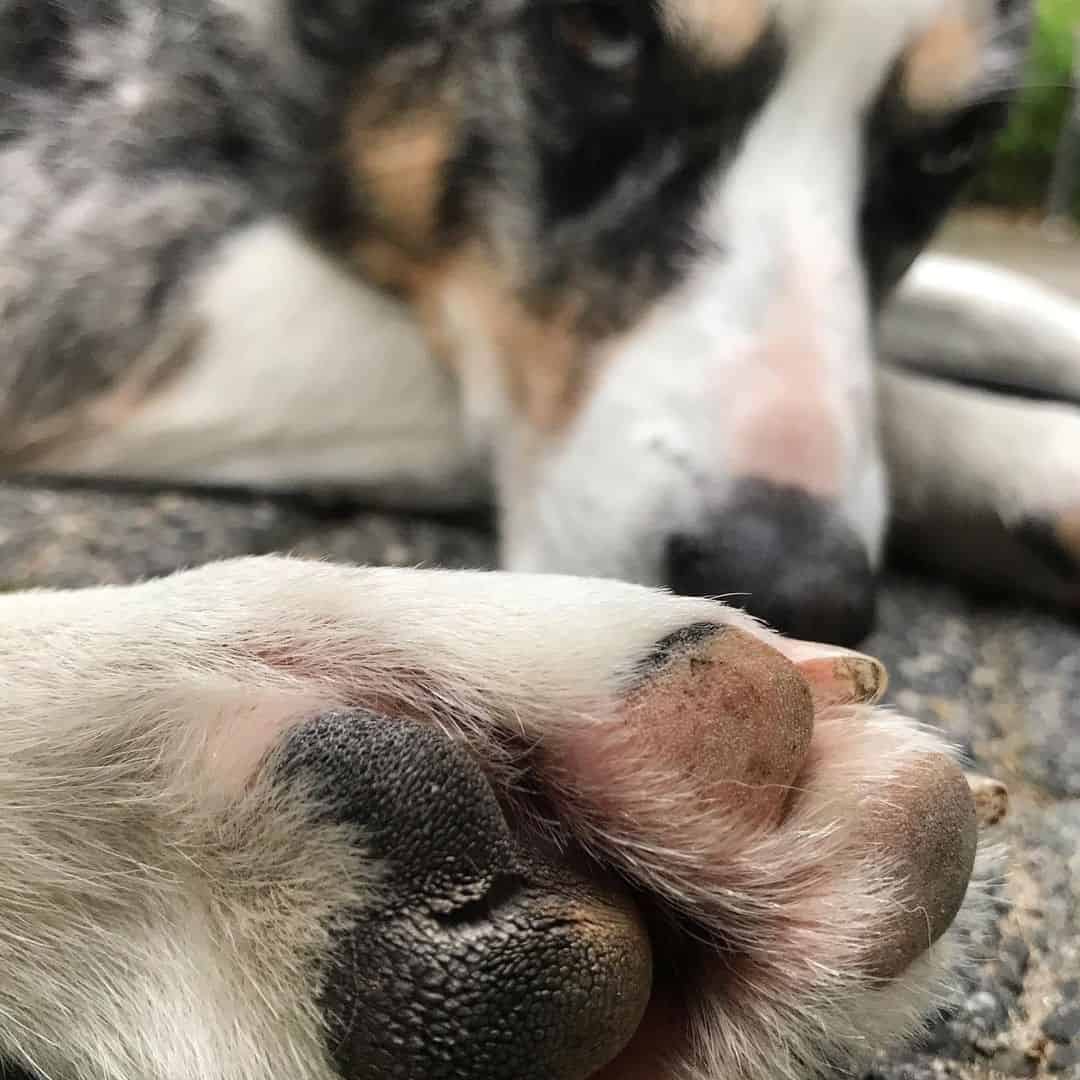
It’s definitely nothing that’s too alarming as there won’t be any drastic consequences from it if you act quickly enough.
The worst thing that can sprout from this is an infection as the protective layer will reform eventually.
The most important thing is to not panic and to get your dog the necessary treatment to remedy the situation so they can enjoy a discomfort and pain-free time again.
What Can I Do To Protect My Dog’s Paw Pads?
Plenty, and none of it requires too much extra effort outside of what you’ve already been doing for your canine companion aside from a bit of extra mindfulness.
Here’s some of the most useful advice on avoiding more pink areas from showing up on your dog’s paws.
• In order to prevent excessive paw licking, it’s likely to have been caused by an injury or atopic dermatitis, in which case it’s best to avoid the trigger to the allergic reaction as well as any particularly rough walking surface, glass, or debris in case of the former.
If the issue persists, you may need to acquire a medicated shampoo to be able to properly rinse out any lingering allergens on your dog’s body.
• If your dog’s toes or paws change color to a more sickly brown in some spots, then it’s likely that he may have contracted some sort of bacterial or fungal infection and should be treated with proper antibiotics and ointments. Consult with your vet to get the right options presented to you.
• Keep your dog’s paws well insulated and hydrated to prevent cracking in the protective black layer through the use of Vaseline or various other creams and ointments. It’s advised to rub them in well as your dog may end up licking it off otherwise.
• Avoid going over any surfaces that can get particularly hot like metal grates, asphalt, and similar when you take your dog out in the Summer or on a really hot day to prevent painful blisters and burns from forming.
• Avoid going through any particularly questionable terrain in terms of hygiene like swamps, stale water, trash-ridden areas and other potential sources of dangerous bacteria, fungus and pathogens.
It’s not just to protect his paws from potential bacterial and fungal overgrowth which can turn this into a problematic infection, but because it may also affect his overall health should it get into his system.
• Proper hygiene is important too. Be sure to keep up with your dog’s bath time in general, not just to protect your dog’s feet, but the rest of him from parasites like fleas and mites, foot, skin and ear infections and similar issues.
Keep his nails trimmed too as ones that get too long can be a breeding ground for infections of all kinds.
• Maintain your dog’s health in other ways too as a drop in his immune system’s capabilities can make bacterial infections on the paws more likely.
Keep him on a healthy and balanced diet that satisfies his daily nutritional needs and give him enough exercise for the day. Also make sure to avoid any food allergies that could mess with his immune response and health in general.
Stick to high quality dry dog food that fits his unique tastes and which avoids said allergens.
In Conclusion
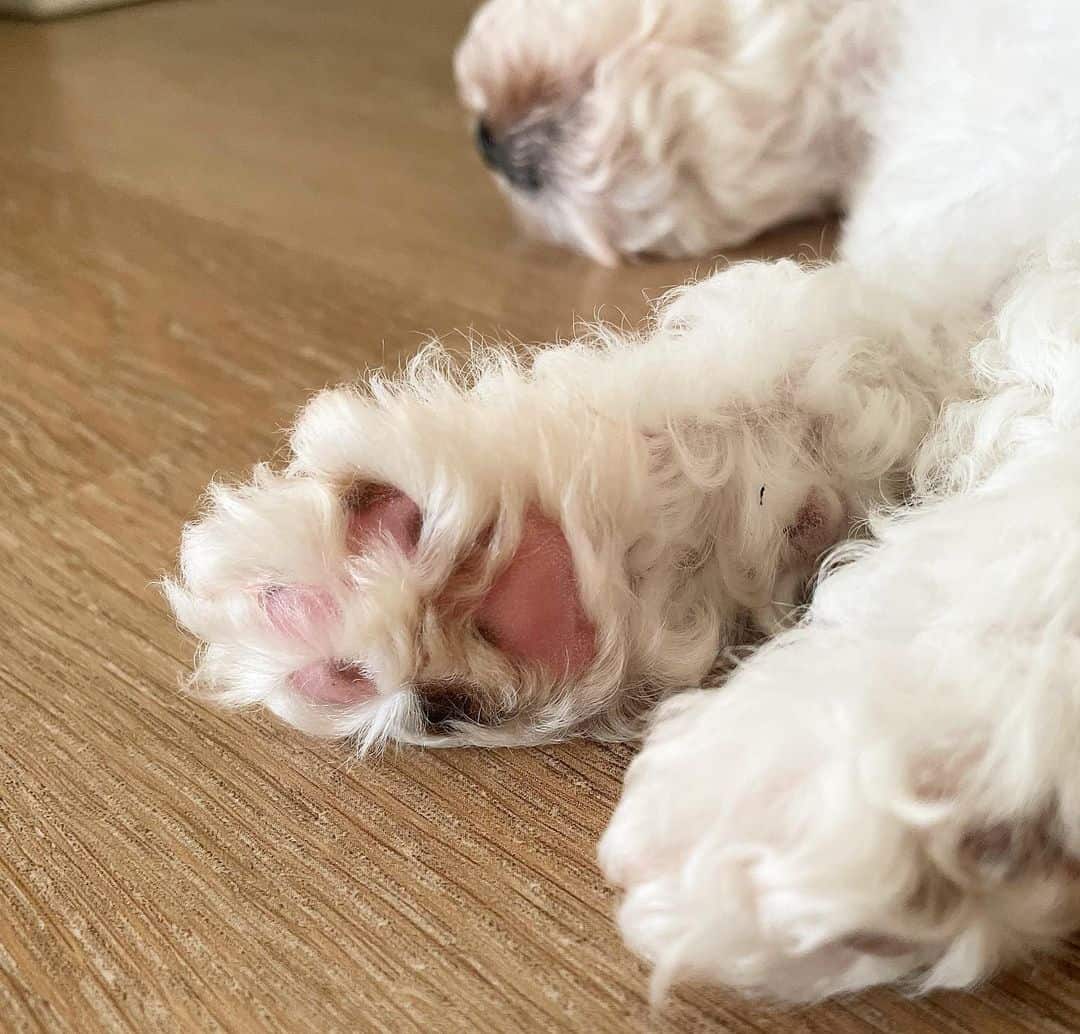
Many owners ask why their dog’s paws are pink and whether that’s normal or something they ought to be concerned about.
It’s something that’s normal for pups and a few breeds out there who maintain that pink pigment throughout their lives.
Most other dogs end up gaining black pigmentation on their paws or form a protective layer over the pink layer.
Some dogs may even end up being in the in-between where they only get partial pigmentation so the paw is part black and part pink.
The paws may revert back to pink from aging as well.
However, there are cases of pink paws, or partially pink ones where the problem stems from an outside source.
Some of the most notable causes end up being various parasites, infections, growths and allergic reactions which can crack through that protective layer or cause pink bits to grow atop the paw, leading to a great deal of discomfort for your precious pupper.
In other cases, it could be a nasty burn from walking on a hot surface, sharp objects or uncomfortable terrain which could end up puncturing the protective layer.
Finally, excessive licking can be the cause of the black protective layer peeling off and exposing the pink layer underneath or his paws may have just ended up getting dry and cracked from lack of hydration.
Each of these could be potential culprits with some of them happening more often than the other.
Thankfully, none of them are fatal or all that serious aside from the odd infection, but all of them can be easily treated by a visit to the vet or through simple lifestyle changes.
Anti-bacterial, anti-fungal and medicated shampoos in general will be your saving grace as will a number of topical ointments.
Overall, the issue isn’t that hard to deal with and is something dog owners have to deal with at least once or twice in a dog’s lifetime.
The most important thing to do is to keep an eye out for your dog’s behavior for any shifts as well as any potential changes on his paw pads.
The sooner you spot them, the quicker the problem can be alleviated and some of the more annoying side-effects can be avoided, especially those from infections.
Whatever the case may be, I’m sure you’re going to have it easily handled with your doggo in mind. Until next time, pet parents.
RELATED LINKS:
